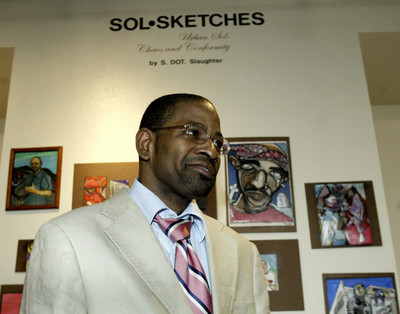Urban Hues

You use too many colors.
That’s what Stanley Slaughter Jr.’s mother told her son when he was a budding young artist.
“She used to tell me it looked like a bowl of Froot Loops,” Slaughter recalls with a smile.
But Slaughter’s love of bright colors didn’t stop his mother from submitting her 10-year-old son’s drawings to a “Call for Young Artists” at Detroit’s Wayne State University — where he received his first scholarship in 1980.
More than 25 years later, Slaughter, who’s now 37, still loves vibrant Froot Loop hues.
A dancer with pink and green hair undulating like seaweed moves against a blue, yellow and green background. Bluesy indigos, violets and greens surround a grizzled pianist. A patch of turquoise sky peeks from behind the shoulder of a tearful Hurricane Katrina victim who hugs a ponytailed rescuer in “Survivors and Helpers of Katrina.”
They’re all part of Slaughter’s trademark “solsketches,” featured in his exhibit “Urban Sol: Chaos and Conformity,” which continues through Oct. 14 at the West Las Vegas Arts Center.
“Over time, the colors sort of create the imagery,” Slaughter says of his work, which reflects a variety of influences, including graffiti and hip-hop.
Just as rappers sample other musicians’ tracks, Slaughter combines hand drawings and computerized images to create multimedia works.
“Today, graffiti gets a bad rap,” says Slaughter, who generally adorns his work with a crown symbol, which was “part of my insignia” during his ’80s graffiti days. But, as he points out, “the Egyptians and the Phoenicians were some of the first graffiti artists.”
Spoken like a true history teacher — which makes perfect sense, considering that Slaughter has taught world history at Rancho High School for the past three years.
Before joining the Rancho faculty, Slaughter taught U.S. and world history, art and graphic design at Andre Agassi College Preparatory Academy, a position the Eastern Michigan University graduate found at a job fair.
“I made some promises to my first- and second- and sixth-grade teachers that someday, I (would) return to the classroom,” Slaughter explains. As an Agassi fan, the opportunity to teach at a charter school founded by the tennis legend proved intriguing.
Slaughter depicts both the school and its namesake, tennis racket in hand, in a portrait featured in the exhibit.
“Tell Andre Agassi to come down and take a look at this,” Slaughter says, surveying his work. “I would like to know what he thinks.”
Plenty of other famous faces peer down from the walls of the West Las Vegas gallery, whether political figures (Malcolm X) or musicians from Billie Holiday to Tupac Shakur.
The most significant image, however, might be filmmaker Spike Lee, who peers down from a multi-image panel (done for a Black History Month project at the University of Michigan) that asks the question “Who Are You?” — and lists descriptions, from “Original Nubian Moor” to “Black Brown Mulatto Negro,” leading to “ONE in a million AFRICAN AMERICAN.”
Like Lee, Slaughter is the son of a musician. With his spectacles and neatly trimmed beard, Slaughter even looks a bit like the famed director.
But Slaughter resembles Lee in an even more significant way: his interest in combining art and social commentary.
“I’d like to see this button pushed a little bit more,” Slaughter says, citing the power of “expressionism in art.”
As an example, he points to a series of works inspired by, and devoted to, those who lived through Hurricane Katrina and its aftermath.
In one image, a firefighter administers oxygen to a young victim. In another, survivors huddle on a bridge, while a third depicts a figure toting a suitcase marked “Refugee.” New Orleans musicians, meanwhile, play on.
The Katrina series took shape as Slaughter viewed “images of despair” on television and online after the hurricane struck. As he worked, however, he opted to include more positive views of people “working across racial and cultural lines.”
Whether the subject is “The Other Las Vegas” (which shows police officers arresting suspects at a shooting scene, while the Strip skyline looms in the background) or silhouettes of figures, chained at the neck, facing “Deportacion,” Slaughter’s art aims to “force the viewer into dialogue and discussion.”
Locals will have ample opportunity to discuss Slaughter’s art this fall; in addition to the West Las Vegas exhibit, his solsketches are on display at the reJAVAnate Coffee Lounge at 3300 E. Flamingo Road.
Next month, Slaughter’s “Sol Reflections” will be exhibited at Cloth & Canvas (4800 S. Maryland Parkway). He also said he plans to participate in a collaborative mural, “Pieces of My Peace,” for the Las Vegas Peace Project on Oct. 13. And Slaughter’s in the spotlight Nov. 15 with a solo exhibition at The Venetian’s Tao. (More information is available online at www.myspace.com/ssketches.)
Next year’s plans include a line of magnets, T-shirts, tote bags and home decor inspired by Slaughter’s solsketches.
Even so, “I don’t present art for money,” Slaughter maintains. “I present art for message.”
That’s a philosophy he’s been developing since his student days, which included a scholarship stint at Los Angeles’ Parsons School of Art & Design.
Yet, despite his formal training, “I don’t think you can go to art school” to become an artist, he says, emphasizing the importance of “an artistic spirit” in any young artist’s development.
“There has to be some creative drive and juice,” Slaughter says.
That “creative juice” must run in the family; Slaughter’s 2-year-old daughter “loves to doodle and dance and draw and sing,” he notes. “She says, ‘Daddy, I’m drawing.’ “
And if she likes Froot Loop colors, so much the better.